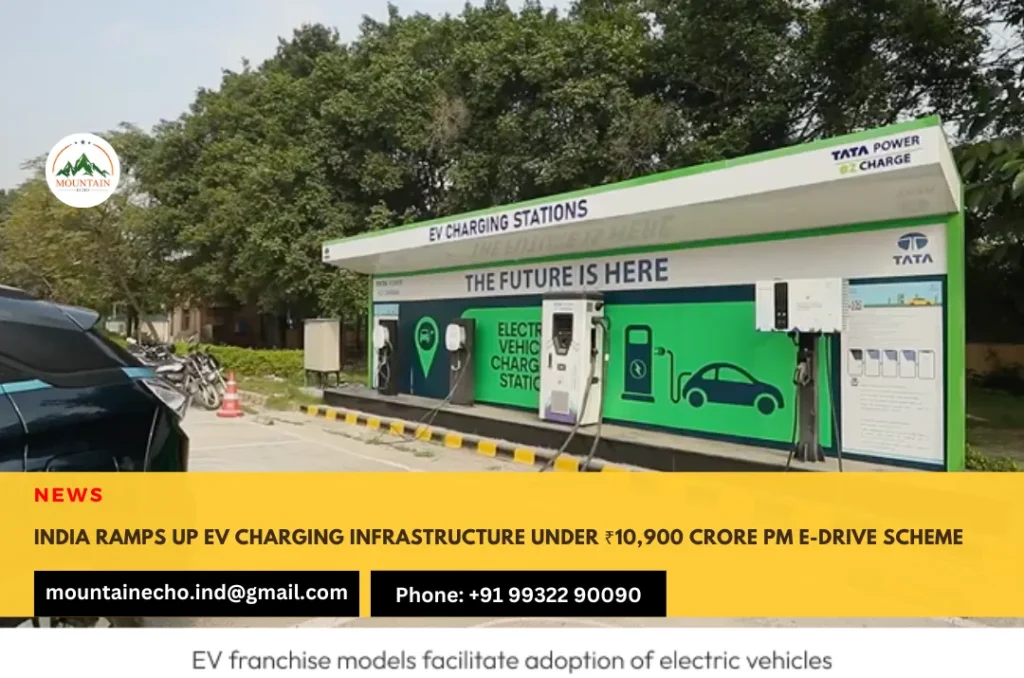India Ramps Up EV Charging Infrastructure Under ₹10,900 Crore PM E-Drive Scheme
WhatsApp Channel
Join Now
The Indian government is making a significant push to expand EV charging infrastructure as a crucial element in promoting EV adoption and reducing reliance on internal combustion engine vehicles. The primary policy vehicle for this effort is the PM E-Drive (PM Electric Drive Revolution in Innovative Vehicle Enhancement) Scheme, with a total outlay of ₹10,900 crore.
A substantial portion of the PM E-Drive scheme, ₹2,000 crore, has been specifically allocated for the establishment of EV charging points and battery-swapping stations nationwide.
The Ministry of Heavy Industries (MHI) is at the forefront of this initiative, actively coordinating with key stakeholders, including the Airports Authority of India (AAI), the National Highways Authority of India (NHAI), the Ministry of Ports, Shipping and Waterways, and various state governments. This collaboration aims to identify optimal locations for charging infrastructure across critical transport hubs.
A senior government official confirmed the collaborative effort, stating, “The Ministry of Heavy Industries is coordinating with AAI, NHAI, the Ministry of Ports, Shipping and Waterways, and various state governments to determine optimal locations for EV charging stations.”
Another official noted the inter-ministerial discussions, saying, “We have received input from 14 states and conducted an inter-ministerial meeting. Once we get additional feedback from relevant departments, we will finalize the guidelines by April.”
The government has set a target to increase the number of public charging stations from the current 32,500 to 72,300 by FY26. This ambitious goal underscores the urgency of developing a robust charging network to support the growing EV market.
The PM E-Drive scheme offers subsidies of up to 80 percent for the cost of upstream infrastructure for fast public EV charging stations. In specific cases, particularly in northeastern, coastal, and hilly regions, full funding may be considered, including the cost of upstream power infrastructure.
And, in a move to accelerate charger deployment, the MHI is likely to remove the mandatory 50% domestic value addition (DVA) rule under the PM E-Drive Scheme for charger manufacturers.
An official stated, “There will be no DVA condition in the upcoming chargers’ phased manufacturing programme guidelines, as there is an urgent need to establish a robust charging network.”
This decision aims to allow manufacturers to import critical components and expedite infrastructure development, addressing concerns about the slow rollout of charging stations.
Focus Areas for Charging Infrastructure Development
The government’s strategy focuses on establishing charging infrastructure across key transportation corridors and hubs:
High-Traffic Corridors: Major national highways with high truck traffic are being prioritized for charging infrastructure to facilitate long-haul EV travel. NHAI will handle the tendering process, while MHI will provide financial backing, covering up to 80% of project costs. Examples include the Mumbai-Pune and Bengaluru-Chennai highways.
Transport Hubs: Airports, ports, and railway stations are identified as critical locations for establishing EV charging stations and battery-swapping facilities. The MHI is in discussions with the AAI, NHAI, and the Ministry of Ports, Shipping and Waterways to identify potential locations. Existing infrastructure at hubs like Delhi’s Indira Gandhi International Airport and Kochi Airport already includes EV charging facilities.
Urban Centres: Priority is being given to commercial vehicles like electric three-wheelers in cities, with a target of 2.05 lakh such vehicles on the road by 2026.
Battery Swapping Infrastructure
The government is actively incorporating battery-swapping facilities into its EV infrastructure plans. The ₹2,000 crore allocated under the PM E-Drive scheme includes provisions for setting up battery-swapping stations.
Proposals for battery-swapping facilities submitted by airports, ports, and NHAI will be approved, provided they comply with the power ministry’s safety and technical guidelines.
While the number or size of batteries will not be specified by the government, service-level agreements covering aspects like uptime, power quality, and service specifics will be crucial for operators. This might necessitate companies purchasing their own batteries to meet these requirements.
As the official noted, “To ensure this level of service, companies may need to purchase batteries… This will ultimately be decided by AAI, NHAI, and state governments.”
The government is open to providing subsidies for swapping stations as part of the scheme.
Current Status and Progress
As of March 2025, India has around 26,367 public EV charging stations (PCSs) deployed across the country. Karnataka has the highest number (5,879), followed by Maharashtra (3,842), Uttar Pradesh (2,113), Delhi (1,951), and Tamil Nadu (1,495).
Between March 2023 and February 2024, the number of operational public EV charging stations almost doubled from 6,586 to 12,146.
The volume of electricity consumed by public charging stations rose by almost 85 percent year-on-year during the first three quarters of FY25, reaching 590.06 million units (MU). Delhi accounted for the highest consumption (258.83 MU), followed by Maharashtra (149.67 MU).
The EV charging infrastructure sector has attracted significant investment, with over $450 million (approximately ₹30,000 crores) already invested in start-ups operating charging networks and battery-swapping models. Over the past five years (2020-24), around 50 Indian start-ups have cumulatively raised close to USD 511 million.
Challenges and Considerations
Despite the progress, several challenges remain:
Low Utilisation Rates: The current financial viability for PCSs is low, with utilisation rates below 2 per cent. To achieve profitability and scalability, rates need to reach around 8-10 per cent by 2030.
High Infrastructure Costs: Building charging stations is capital-intensive.
Lack of Uninterrupted Power Supply: Ensuring a reliable power supply to charging stations is crucial.
Standardisation and Interoperability: The need for standardised protocols to enable interoperability between different charging networks and EVs remains a challenge.
Electricity Tariffs: The current cost structure of electricity tariffs, with fixed charges regardless of energy consumption, combined with low utilisation, makes it challenging to achieve break-even for charging station operators in some states with high fixed tariffs. The FICCI report highlighted that “the current cost structure of electricity tariffs with fixed charges regardless of energy consumption combined with low utilisation at PCSs is making it challenging to achieve break even.”
Land Acquisition Hurdles: Securing suitable land for charging stations can be difficult.
Grid Reliability: Ensuring the electricity grid can support the increased demand from EV charging infrastructure is essential.
Low EV Penetration in Rural Areas: Expanding charging infrastructure to rural areas remains a challenge due to lower EV adoption rates.
Gap in Charger-to-EV Ratio: India currently has a low ratio of public chargers to EVs (one per 135 EVs), significantly below the global average (one per 6-20 EVs), highlighting the urgent need for expansion.
Strategic Implications and Future Outlook
The government’s strong focus on expanding charging infrastructure is a critical enabler for achieving its goal of EVs constituting 30% of new private vehicle registrations (80 million EVs) by 2030. This will require an estimated 3.9 million public and semi-public charging stations.
A robust charging network will mitigate ‘range anxiety’ among potential EV buyers, encouraging wider adoption.
The transition to EVs, supported by a comprehensive charging infrastructure, is crucial for reducing carbon emissions from the transportation sector and achieving India’s decarbonization goals. The growth of the EV ecosystem, including charging infrastructure development and operation, presents economic and employment opportunities.
The report by GameChanger Law Advisors and Speciale Invest suggests that India can learn from the experiences of global EV leaders like California, the UK, and Singapore, particularly in adopting incentive-driven models and streamlining regulations.
Amrut Joshi, founder of GameChanger Law Advisors, emphasised the need for a “collaborative approach—where government support, private investment, and technological innovation converge to build a resilient, future-ready charging network.”
Vishesh Rajaram, managing partner at Speciale Invest, highlighted that “Charging networks present one of the most exciting investment opportunities in energy and mobility today.”
The Indian government is undertaking a concerted effort to significantly scale up EV charging infrastructure across the country. The PM E-Drive scheme, with its dedicated funding and inter-ministerial coordination, provides a strong framework for this expansion.
Telegram Channel
Join Now



